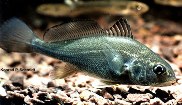http://www.fishbase.org/Summary/speciesSummary.php?genusname=Aplodinotus&speciesname=grunniens ---> http://192.134.151.83/Summary/speciesSummary.php?genusname=Aplodinotus&speciesname=grunniens
http://192.134.151.83/Summary/speciesSummary.php?genusname=Aplodinotus&speciesname=grunniens ---> https://fishbase.mnhn.fr/Summary/speciesSummary.php?genusname=Aplodinotus&speciesname=grunniens
https://fishbase.mnhn.fr/Summary/speciesSummary.php?genusname=Aplodinotus&speciesname=grunniens ---> https://fishbase.mnhn.fr/summary/Aplodinotus-grunniens.html
Aplodinotus grunniens, Freshwater drum : fisheries, gamefish

You can
sponsor
this page
Common name (e.g. trout)
Genus + Species (e.g. Gadus morhua)
-

-
About this page
-
Languages
-
User feedbacks
-
Citation
-
Uploads
-
Related species
-


 Freshwater drum
Upload your
photos
and
videos
Freshwater drum
Upload your
photos
and
videos
Pictures
|
Google image
 Aplodinotus grunniens
Aplodinotus grunniens
Picture by
The Native Fish Conservancy
Teleostei (teleosts) >
Eupercaria/misc
(Various families in series Eupercaria) >
Sciaenidae
(Drums or croakers)
Etymology:
Aplodinotus:
Greek, aploeides = simplicity + Greek,noton = back; single back in reference to the slighty joined dorsal fins (Ref.
45335
)
;
grunniens:
grunniens
meaning grunting (Ref.
10294
)
.
More on author:
Rafinesque
.
Environment: milieu / climate zone / depth range / distribution range
Ecology
Freshwater; demersal; depth range 30 - ? m (Ref.
9988
). Subtropical; ? - 32°C (Ref.
12741
); 58°N - 15°N, 110°W - 70°W (Ref.
86798
)
North and Central America: St. Lawrence-Great Lakes, Hudson Bay and Mississippi River basins from Quebec to northern Manitoba and southern Saskatchewan in Canada and south to the Gulf; Gulf Coast drainages from Mobile Bay in Georgia and Alabama through east Mexico to Rio Usumacinta system in Guatemala.
Size / Weight / Age
Maturity: L
m
?
range ? - ? cm
Max length : 95.0 cm TL male/unsexed; (Ref.
40637
); common length : 45.0 cm TL male/unsexed; (Ref.
9988
); max. published weight: 24.7 kg (Ref.
4699
); max. reported age: 13 years (Ref.
72462
)
Occur in bottoms of medium to large rivers and lakes (Ref.
557
,
10294
). Adults feed on aquatic insect immatures such as mayflies (
Hexagenia
), amphipods, fish (especially shad and young drum), crayfish and mollusks. Larval stages of drum consume larvae of other fishes, while young fishes utilize zooplankton (Ref.
10294
). Known to produce sound. L-shaped otoliths are collected as 'lucky stones' (Ref.
557
). Utilized fresh and can be pan-fried and broiled (Ref.
9988
).
Life cycle and mating behavior
Maturity
|
Reproduction
|
Spawning
|
Eggs
|
Fecundity
|
Larvae
Page, L.M. and B.M. Burr
, 2011. A field guide to freshwater fishes of North America north of Mexico. Boston : Houghton Mifflin Harcourt, 663p. (Ref.
86798
)
IUCN Red List Status (Ref.
130435
)
Least Concern (LC)
; Date assessed:
03 February 2019
CITES
Not Evaluated
Not Evaluated
Threat to humans
Harmless
Human uses
Fisheries: minor commercial; gamefish: yes
FAO - Aquaculture:
production
; Fisheries:
landings
; Publication:
search
|
FishSource
|
More information
Countries
FAO areas
Ecosystems
Occurrences
Introductions
Stocks
Ecology
Diet
Food items
Food consumption
Ration
Common names
Synonyms
Metabolism
Predators
Ecotoxicology
Reproduction
Maturity
Spawning
Spawning aggregation
Fecundity
Eggs
Egg development
Age/Size
Growth
Length-weight
Length-length
Length-frequencies
Morphometrics
Morphology
Larvae
Larval dynamics
Recruitment
Abundance
BRUVS
References
Aquaculture
Aquaculture profile
Strains
Genetics
Electrophoreses
Heritability
Diseases
Processing
Nutrients
Mass conversion
Collaborators
Pictures
Stamps, Coins Misc.
Sounds
Ciguatera
Speed
Swim. type
Gill area
Otoliths
Brains
Vision
Tools
Bio-Quiz
|
E-book
|
Field guide
|
Identification keys
|
Length-frequency wizard
|
Life-history tool
|
Point map
|
Classification Tree
|
Catch-MSY
|
Special reports
Check for Aquarium maintenance
|
Check for Species Fact Sheets
|
Check for Aquaculture Fact Sheets
Download XML
Summary page
|
Point data
|
Common names
|
Photos
Internet sources
AFORO (otoliths) |
Alien/Invasive Species database
|
Aquatic Commons
|
BHL
|
Cloffa
|
BOLDSystems
|
Websites from users
|
Check FishWatcher
|
CISTI
|
Catalog of Fishes
:
genus
,
species
|
DiscoverLife
|
ECOTOX
| FAO - Aquaculture:
production
; Fisheries:
landings
; Publication:
search
|
Faunafri
| Fishipedia |
Fishtrace
| GenBank:
genome
,
nucleotide
|
GloBI
|
GoMexSI
(interaction data)
|
Google Books
|
Google Scholar
|
Google
|
IGFA World Record
|
MitoFish
|
Otolith Atlas of Taiwan Fishes
|
PubMed
| Reef Life Survey | Socotra Atlas |
Tree of Life
| Wikipedia:
Go
,
Search
|
World Records Freshwater Fishing
|
Zoobank
|
Zoological Record
Estimates based on models
Phylogenetic diversity index (Ref.
82804
): PD
50
= 1.0000 [Uniqueness, from 0.5 = low to 2.0 = high].
Bayesian length-weight: a=0.01023 (0.00601 - 0.01743), b=3.21 (3.06 - 3.36), in cm total length, based on LWR estimates for this species & (Sub)family-body (Ref.
93245
).
Trophic level (Ref.
69278
): 3.4 ±0.43 se; based on food items.
Resilience (Ref.
120179
): Medium, minimum population doubling time 1.4 - 4.4 years (tmax=10).
Fishing Vulnerability (Ref.
59153
): High vulnerability (58 of 100).
Price category (Ref.
80766
):
Medium
.
Back to Search
Random Species
Back to Top
Accessed through:
Not available
FishBase mirror site :
localhost
Page last modified by :
mrius-barile
- 20 July 2016
Fatal error
: Uncaught ArgumentCountError: Too few arguments to function checkEcotox(), 1 passed in /var/www/html/summary/speciessummary.php on line 2304 and exactly 3 expected in /var/www/html/includes/speciessummary.lib.php:2579 Stack trace: #0 /var/www/html/summary/speciessummary.php(2304): checkEcotox() #1 {main} thrown in
/var/www/html/includes/speciessummary.lib.php
on line
2579
|